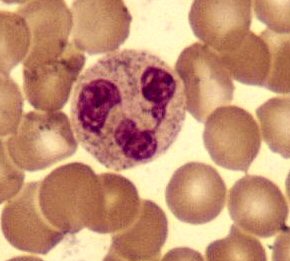Neutrophilic granulocytes
Neutrophilic granulocytes (neutrophils, polymorphonuclear leukocytes or microphages) are white blood cells which, together with eosinophils and basophils, are granulocytes.
The importance of anti-infective defense lies in defense against extracellular bacteria. Neutrophils are able to perform effector functions immediately, without signals from other cells.
They make up 60-70% of peripheral blood leukocytes. They occur in the bloodstream for 6-12 hours and in the tissue for 4-5 days. Only 7% of the total number is found in the peripheral blood, 93% is found in the bone marrow (it changes under the influence of inflammatory cytokines and bacterial products). The major chemotactic agent is the chemokine IL-8.
- Function
The main function of neutrophils is phagocytosis. Their azurophilic granules contain many lytic enzymes. When killing microbes, they can cause so-called oxidative flare-ups with a sufficient supply of energy. At the same time, they secrete substances that lead to the development of an inflammatory response.
Neutrophils cannot divide or supplement their granular equipment. Activated neutrophils die after performing their functions and become part of the inflammatory deposit. Dead neutrophils form pus.
In addition to phagocytosis, neutrophils also form extracellular networks - NETs (Neutrophil Extracellular Traps). Neutrophil granulocytes die other than by necrosis and apoptosis - a process called NETosis (also called suicidal NETosis). The action of foreign pathogens or cholesterol and urate crystals induces changes within the neutrophil: loss of heterochromatin arrangement, disruption of nuclear segmentation, disintegration of the nuclear envelope, disintegration of mitochondria. The caryoplasm and cytoplasm mix, the cell membrane ruptures and they are released into the ECT as part of the future network. Upon spreading the mixture released from the cell, NET is formed, which is a thin fiber derived from nuclear chromatin with granular and cytoplasmic neutrophil enzymes. This complex network serves mainly to capture and immobilize microorganisms, associates with antimicrobial peptides and helps eliminate bacteria. NETs are involved in both physiological and pathological inflammation and can cause alteration if the regulation of their production is disturbed. The pathological consequences of NETosis are, for example inflammatory changes in the development of atherosclerosis, the development of lung diseases (e.g. COPD) and autoimmune disorders (especially lupus erythematosus).
Neutrophils are not among APCs!
- Development line
Bone marrow myelodide progenitor cell → myeloid precursor → neutrophil.
The progenitor cell, not just neutrophils, has an adhesive molecule CD34. It is found in small numbers in the marrow for life.
Their nucleus is made up of 2–5 lobes, the number of lobes increases with the age of the cell (the youngest forms of neutrophils do not have a segmented nucleus and are therefore referred to as rods). There are small, light pink granules in the cytoplasm of neutrophils. Their main role is phagocytosis.
Source[edit | edit source]
References[edit | edit source]
- HOŘEJŠÍ, Václav – BARTŮŇKOVÁ, Jiřina. Základy imunologie. 3. edition. Praha : Triton, 2008. 280 pp. ISBN 80-7254-686-4.
- ŠVÍGLEROVÁ, Jitka. Neutrofilní granulocyty [online]. The last revision 2009-02-18, [cit. 2010-11-12]. <https://web.archive.org/web/20160306065550/http://wiki.lfp-studium.cz/index.php/Neutrofilní_granulocyty>.


